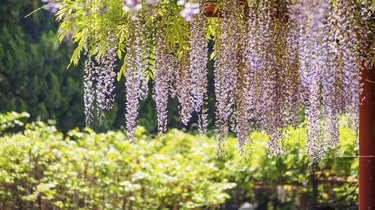
Wisteria (Wisteria spp.) vines display spectacular spring blooms, consisting of long, pendulous flower clusters that can reach 3 feet in some varieties. Flower colors include violet, lavender and white, depending on the variety. The vines are vigorous growers, so you need to prune them to restrict their rampant growth. Summer pruning also encourages flowering. If you don't control growth, wisteria vines can overwhelm other plants and strangle nearby trees.
Growing Wisteria
Video of the Day
The major species of wisteria, Chinese wisteria (Wisteria sinensis), American wisteria frutescens) and Japanese wisteria (Wisteria floribunda), grow well in sun to light shade in U.S. Department of Agriculture plant hardiness zones 5 through 8, 5 through 9 and 4 through 9, respectively. Wisteria vines can grow 10 feet per year and reach up to 35 feet or more, if not pruned. The twining vines turn woody with age and require a sturdy support, such as an arbor, a pergola or trellis. In spring, the long hanging flower clusters increase the weight of the vines.
Video of the Day
Pruning Newly Planted Wisteria
Plant wisteria in spring or fall. When you plant a wisteria, you need to decide if you want to grow it as a single- or multi-trunked plant. For a multi-stemmed wisteria, select several strong stems and cut off all others. If your plant has only one stem, prune it back to encourage growth of new stems at the cut site. To grow a single-stemmed wisteria, prune out all stems except for one. You can grow a single-stemmed wisteria as a tree-like plant with proper pruning and an upright support. Let the wisteria grow and then prune it back to a chosen height so that the wisteria will produce side shoots.
Summer Pruning to Encourage Flowering
Wisteria is a vigorous climber and produces long whip-like shoots all summer long. These long shoots attach and twist themselves around any kind of nearby plant or object. In summer, cut back all the long side shoots to five or six leaves, or down to about 6 inches. Leaves consist of up to 13 to 15 lance-shaped leaflets. Wait until after flowering before cutting shoots on mature wisteria vines. Cut and pull out any suckers that grow next to your stem or original stems. Pruning all this vegetative growth will help the wisteria put its energy into producing flowers next spring. It may take several years for a newly planted wisteria to bloom. You may need to cut the whip-like shoots several times during the summer months.
Winter Pruning to Control Size and Shape
Once your wisteria has developed a main stem framework, either single- or multi-stemmed, prune it every winter. It is easy to see the wisteria stem framework in winter, because all stems are leafless. Thin out excess growth. On flowering wisterias, cut back flowering stems to two or three short, fat buds. These buds will produce flowers in spring. If you cannot tell if you have flowering shoots, just cut side shoots, pruned the previous summer, down to about 2 inches. Because wisteria is such a vigorously growing vine, you may need to cut up to 50 percent of wisteria stems and lateral branches annually.
Using Pruning Tools
Hand clippers or pruners are sufficient for pruning all new soft growth on wisteria. For older, woody growth, use long-handle loppers or a pruning saw. To reach branches or side shoots up on the roof of a pergola or high on a trellis without using a ladder, prune with a pole saw or a pole pruner. To keep pruning tools working well, periodically sharpen pruners and add a drop of motor oil on the moving parts. To avoid spreading disease among wisteria, wipe the blades of pruning tools with a cloth soaked in rubbing alcohol or submerse them in a solution of 1 part bleach to 9 parts water.
- Royal Horticultural Society: Wisteria: Pruning
- Missouri Botanical Garden: Wisteria sinensis
- Missouri Botanical Garden: Wisteria frutescens
- Fine Gardening Plant Guide: Japanese Wisteria
- The Ohio State University Extension: Growing Wisteria
- National Gardening Association: Wisteria
- Fine Gardening: Pruning and Training Wisteria